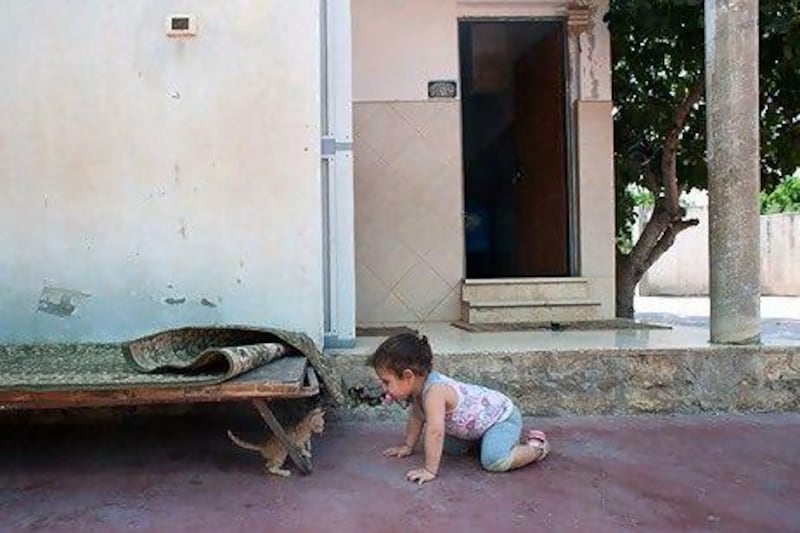LOD, ISRAEL // The two neighbourhoods in the mixed Jewish-Arab city of Lod could not have been more different.
Kerem Al Tufaah, home to about 1,000 Arab Israelis, is rundown and neglected. The streets have no names, the houses have no numbers and the roads are unpaved, have no lampposts and are littered with used nappies, soft drink bottles, empty cigarette packs and other rubbish.
Across from a road and an Arab cemetery is Ramat Elyashiv, a new community that will accommodate hundreds of religious and ultranationalist Jewish families. Multi-storied buildings with balconies, penthouses and sprawling parking lots line the newly paved, well-lit and clean streets, surrounded by a park and gardens.
While such a contrast exists between Arab and Jewish neighbourhoods in other mixed Israeli cities, it is especially evident in Lod, a town about 20 kilometres away from Tel Aviv that is tucked away behind Israel's international Ben-Gurion Airport. There, the Arab community has grown increasingly embittered and alienated from local authorities, who they accuse of ignoring Arab neighbourhoods' existence, depriving them of public services and rarely granting permits to build new homes. Last month, however, a group of Arab activists and residents from Kerem Al Tufaah decided to tap Israel's legal system in a bid to reverse the inequality.
At stake is an empty but rubbish-littered lot. Residents say it is the only area available for them to build desperately-needed housing but the local authorities have reserved the site for a new seven-storey police station. The court petition filed by two Israeli rights groups on behalf of the residents is the latest demonstration of tension between Israel and its Arab minority, which make up about 20 per cent of the population and face discrimination in areas such as housing, education and health. The housing inequality is especially acute for Israeli Arabs, who mostly live in Arab villages and towns while about 10 per cent of them reside in mixed cities such as Lod.
Indeed, Israeli planning authorities have for decades neglected updating building plans for many Arab communities across Israel that would allow growing families to legally construct homes.
The roots of Kerem Al Tufaah predate Israel's 1948 creation yet it is officially nonexistent. Its territory is included in a 1979 general plan of Lod, but a detailed plan for the neighbourhood as well as for the adjacent disputed lot - a requirement for granting building permits - has never been drafted. That is why residents have so far not been allowed to construct homes on the lot, activists say.
"They want to squeeze us out of Lod," said Ibrahim Abu Salok, a 52-year-old Arabic to Hebrew translator who represents Kerem Al Tufaah residents. "I pay the same taxes as Jewish residents and keep the law so there is no reason to treat us and Elyashiv differently."
Lod activists say the housing discrimination Arabs face has helped turn their communities into overcrowded, impoverished, crime- and drug-ridden slums.
Partly, that has also been spurred by the lack of Arab officials in Lod's local government, compared with other mixed Jewish-Arab cities that do have Arab representatives, according to activists.
A study by the Israeli rights group Shatil last year showed that 70 per cent of Arabs' homes in Lod were built illegally and activists say hundreds of them face demolition orders. Moreover, according to activists, authorities have issued plans for new industrial zones or roads that are built on areas occupied by long-established but illegally-built Arab homes, forcing the demolition of those houses. Rights groups have charged that the city is trying to "Judaise" its Arab communities. Indeed, Ramat Elyashiv was established on what used to be an Arab neighbourhood after the latter's residents received financial compensation for leaving.
The municipality then enticed Jews - many of them from Jewish settlements in the West Bank - to move into Ramat Elyashiv homes by offering them below-market prices, such as US$100,000 (Dh367,250) for a four-bedroom flat, according to Israeli media reports.
A spokesman for the Lod municipality declined to comment on the building permit rejections and said the illegal construction is a "severe phenomenon that hurts law enforcement". He added that the municipality implements a "stringent" policy towards such building, including by levelling homes.
In Kerem Al Tufaah, the plan to build the police station has renewed fury among residents, who live in tenement-style houses, about their living conditions.
"We don't have playgrounds, youth centres, lots to legally build on, roads or even trash bins on the street," said Ahmad Nimer, a 33-year-old unemployed gardener, as he sat in the shade outside his extended family's house. Mr Nimer said that renting an apartment out of the neighbourhood was too expensive and that six years ago he illegally built a two-room unit outside his parents' home for him, his wife and their two children. His brother, 32-year-old Ibrahim, crams together with his wife and three children into a single room that extends from his parents' home.
For them, the only nearby open space for a new home is the nearby barren field that activists say is large enough for about 300 houses.
"This lot could cancel the historic discrimination against these people," said Auni Bana, a lawyer with the Association for Civil Rights in Israel, one of the groups that filed the petition.
"We have only this lot to improve the lives of people in this neighbourhood, but hundreds of other places to build a police station."





